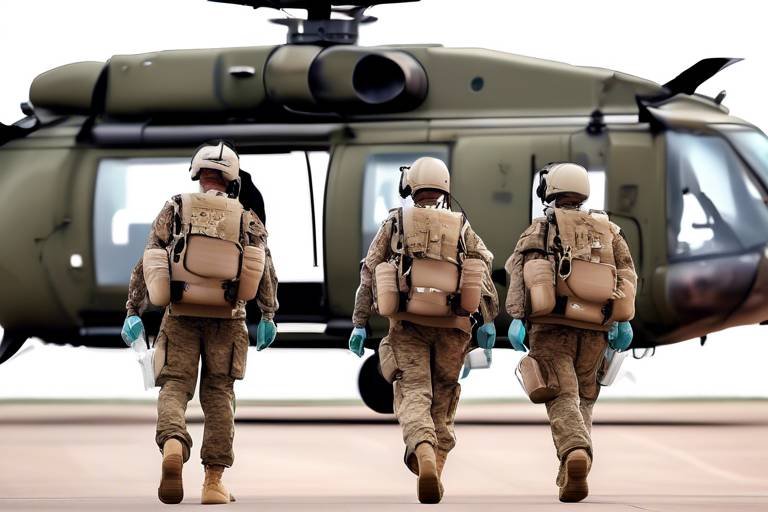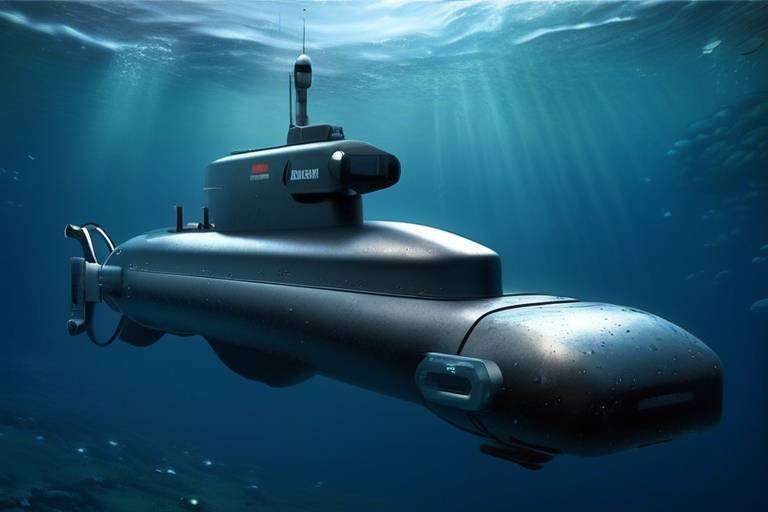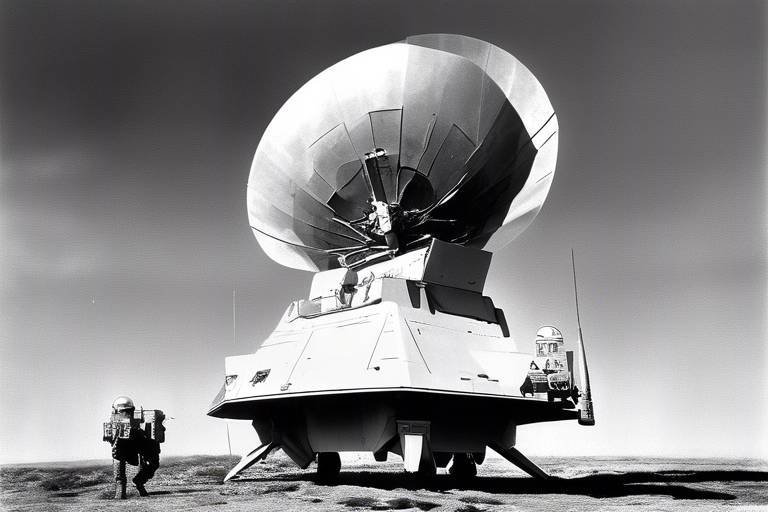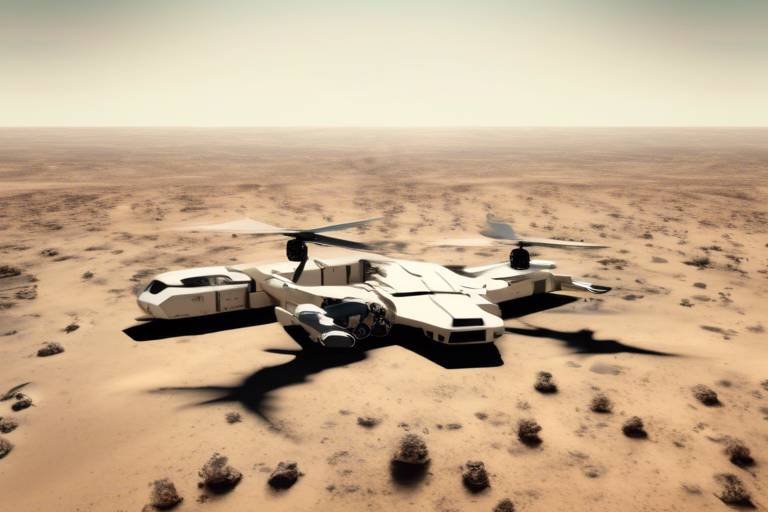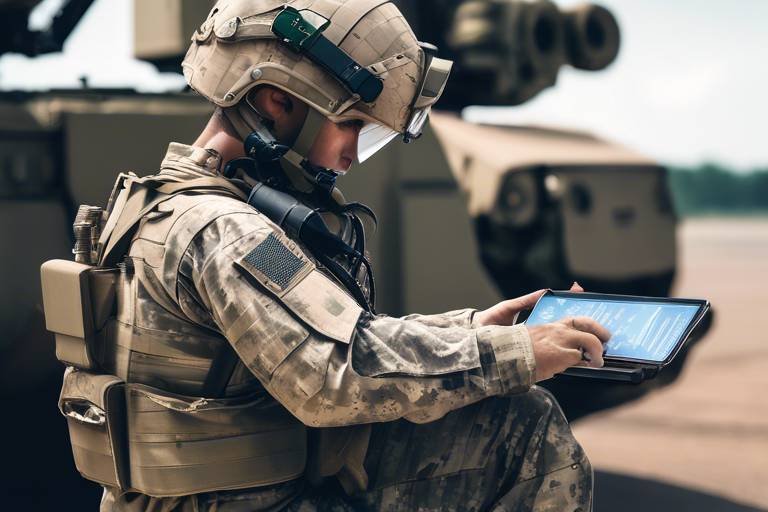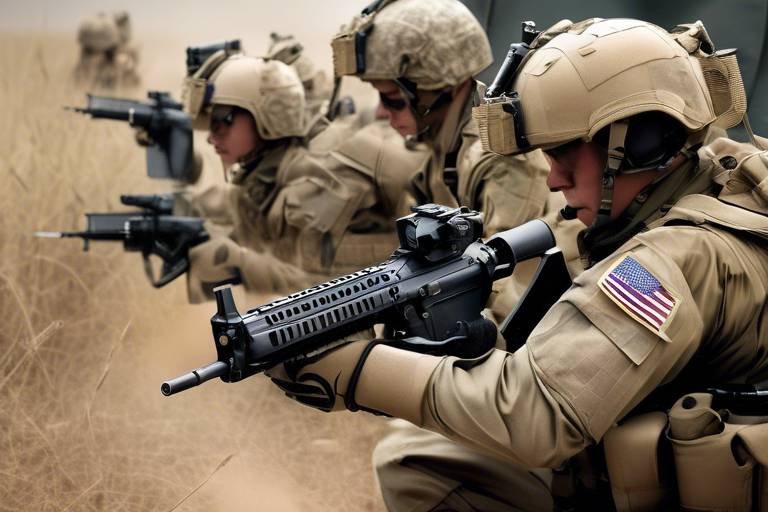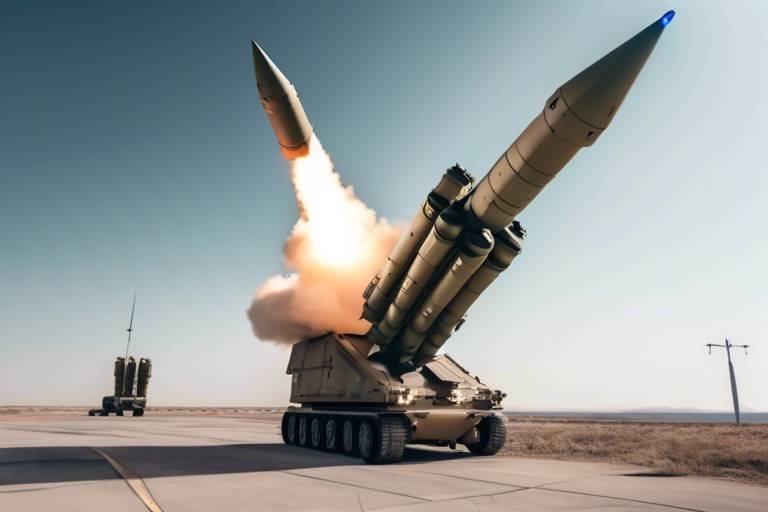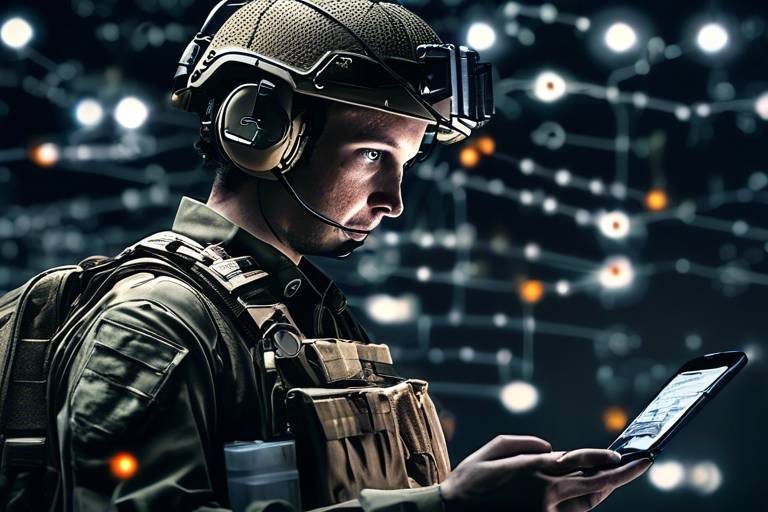Innovations in Tactical Communication for Military Units
The landscape of military operations is constantly evolving, and at the heart of this evolution lies the critical need for effective communication. In today’s fast-paced and unpredictable environments, the ability to communicate swiftly and securely can mean the difference between mission success and failure. Innovations in tactical communication are paving the way for military units to enhance their coordination, efficiency, and overall effectiveness. As we delve into the latest advancements, it’s clear that these technologies are not just tools; they are lifelines that connect soldiers in the field with their command and support networks.
Imagine being on the battlefield, surrounded by chaos, and yet, you can communicate with your team without any interruptions. This is not a distant dream; it’s becoming a reality thanks to the latest advancements in communication technologies. From enhanced radio systems to artificial intelligence, the tools at the disposal of military personnel are becoming increasingly sophisticated. These innovations are designed not just to keep soldiers in touch, but to ensure that they are always one step ahead in their operations.
One of the most significant breakthroughs is in the realm of enhanced radio systems. Modern military communication relies heavily on these advanced systems that provide clearer signals and greater range. Imagine a soldier in a dense forest or a remote desert—traditional communication methods might falter, but with these new systems, communication remains robust and secure. This is achieved through improved encryption methods that prevent unauthorized access, ensuring that sensitive information remains confidential.
Furthermore, the integration of mobile communication platforms allows personnel to maintain connectivity on the move. This capability is crucial during missions where real-time information sharing can significantly impact decision-making. Think about it: when a unit is under pressure, having the ability to communicate instantly can mean the difference between life and death. This mobility not only enhances operational effectiveness but also boosts the morale of troops who feel connected to their command.
As we explore further, we encounter the revolutionary advancements in satellite communication technology. The ability to communicate over vast distances has transformed military operations, especially in remote locations where traditional communication methods might fail. Recent developments in miniaturized satellite devices have made it easier for troops to deploy these capabilities without the burden of heavy equipment. This means that soldiers can maintain their mobility and flexibility even in dynamic combat situations.
Moreover, the introduction of Low Earth Orbit (LEO) satellites has changed the game entirely. These satellites offer lower latency and higher bandwidth, allowing for faster data transmission and improved connectivity. Imagine the relief of a commander knowing that their orders can be communicated instantly, regardless of the battlefield’s location. This advancement not only enhances communication but also significantly improves situational awareness, which is vital for coordinating responses to emerging threats.
In addition to these technological advancements, the integration of artificial intelligence into communication systems is another groundbreaking development. AI enhances data processing capabilities, enabling predictive analytics and automated responses. This means that military units can streamline their decision-making processes, making them more agile and responsive to changing situations. For example, AI-powered translation tools break down language barriers, facilitating seamless communication between multinational forces during joint operations.
Furthermore, employing AI for predictive maintenance ensures that communication gear remains operational. By anticipating equipment failures, military units can reduce downtime and maintain operational readiness, which is critical during high-stakes missions. As we can see, the integration of AI into military communication is not just a trend; it’s a vital component of modern warfare.
However, with these advancements comes the pressing need for robust cybersecurity measures. As communication technologies evolve, so do the threats posed by cyber adversaries. Protecting sensitive military information is paramount, and advanced encryption technologies play a crucial role in safeguarding communications against interception. This ensures that only authorized personnel can access critical information during operations, maintaining the integrity of tactical communications.
Lastly, training military personnel in cybersecurity best practices enhances resilience against cyber-attacks. In a world where digital threats are ever-present, ensuring that units can maintain their operational capabilities is essential. By investing in training, military organizations can foster a culture of cyber awareness, empowering soldiers to protect themselves and their communications.
- What are the key innovations in military communication?
Key innovations include enhanced radio systems, mobile communication platforms, satellite communication advancements, and the integration of artificial intelligence. - How do AI-powered tools improve military communication?
AI-powered tools enhance data processing, facilitate real-time translation, and enable predictive maintenance for communication equipment. - Why is cybersecurity important in military communications?
Cybersecurity is crucial to protect sensitive information from cyber threats, ensuring the integrity and confidentiality of communications.

Enhanced Radio Systems
Modern military communication has undergone a profound transformation, primarily due to the introduction of . These systems are not just about sending and receiving messages; they are the backbone of operational success in today's complex battlefield environments. Imagine being in a dense forest, surrounded by the sounds of nature, and yet having the ability to communicate clearly with your team miles away. This is the power of advanced radio technology. With clearer signals, greater range, and improved encryption, military units can communicate effectively in a variety of terrains and conditions.
One of the standout features of these enhanced radio systems is their ability to operate in challenging environments. Whether it's a mountainous region, urban landscape, or even underwater, these systems are designed to maintain robust connectivity. The integration of advanced modulation techniques and frequency-hopping spread spectrum technology ensures that signals remain strong and less susceptible to interference. This means that troops can focus on their mission without the constant worry of losing communication with their command.
Moreover, the importance of security in military communications cannot be overstated. Enhanced radio systems come equipped with state-of-the-art encryption protocols that safeguard sensitive information from potential adversaries. Just like a secret code that only a select few can decipher, these systems ensure that only authorized personnel can access critical communications. This is crucial in operations where the stakes are high, and any breach can lead to catastrophic consequences.
In addition to improved security, these systems also offer a range of functionalities that enhance operational effectiveness. For instance, many modern radios now feature integrated GPS capabilities, allowing units to share their locations in real-time. This feature is invaluable during missions where situational awareness is key. Imagine being able to see where your teammates are positioned on a digital map while coordinating an assault. It not only increases efficiency but also reduces the risk of friendly fire incidents.
Furthermore, the user interface of these radios has evolved dramatically. Gone are the days of bulky, complicated devices. Today's enhanced radio systems are designed with the user in mind, featuring intuitive controls and displays that make it easy for soldiers to operate them under pressure. This ease of use can be the difference between life and death in a fast-paced combat scenario.
Let's take a look at a comparison of traditional radio systems versus enhanced radio systems:
| Feature | Traditional Radio Systems | Enhanced Radio Systems |
|---|---|---|
| Signal Clarity | Often distorted | Crystal clear |
| Range | Limited | Extended |
| Encryption | Basic | Advanced |
| GPS Integration | No | Yes |
| User Interface | Complex | Intuitive |
In conclusion, enhanced radio systems are not just a technological upgrade; they represent a fundamental shift in how military units communicate and operate. As these systems continue to evolve, we can expect even greater advancements that will further improve the effectiveness and safety of military operations. In a world where every second counts, having the right communication tools can mean the difference between mission success and failure.
- What makes enhanced radio systems different from traditional systems?
Enhanced radio systems offer superior signal clarity, extended range, advanced encryption, and integrated GPS functionalities, providing a significant upgrade over traditional systems. - How do enhanced radio systems improve operational effectiveness?
By providing clear communication, real-time location sharing, and intuitive user interfaces, these systems allow military personnel to coordinate more effectively during missions. - Are enhanced radio systems secure?
Yes, they incorporate advanced encryption technologies to protect sensitive communications from interception by unauthorized parties.

Mobile Communication Platforms
The integration of has revolutionized the way military personnel operate in the field. Imagine being in the midst of a high-stakes mission, where every second counts, and having the ability to communicate seamlessly with your team, regardless of where you are. This is the reality that modern technology has brought to military operations. With the advent of mobile devices and applications designed specifically for tactical environments, soldiers can now share real-time information, coordinate actions, and make informed decisions on the fly.
One of the most significant advantages of these platforms is their ability to maintain connectivity while on the move. Traditional communication methods often required soldiers to remain stationary, which could be a liability during dynamic operations. However, with mobile communication solutions, troops can stay connected while maneuvering through diverse terrains, from urban landscapes to rugged mountains. This mobility not only enhances operational effectiveness but also increases the safety of personnel by allowing for more flexible and adaptive strategies.
Moreover, these platforms are equipped with advanced features that facilitate communication under challenging conditions. For instance, many mobile communication devices are designed to operate in extreme weather, ensuring that troops can communicate even during rain, snow, or dust storms. The integration of secure messaging applications ensures that sensitive information remains protected while still allowing for quick and efficient communication. This is crucial in high-pressure situations where every piece of information can mean the difference between mission success and failure.
Additionally, mobile communication platforms often utilize a variety of communication channels, including voice, video, and data transmission. This multifaceted approach allows for a more comprehensive understanding of the operational environment. For example, a commander could receive live video feeds from reconnaissance drones while simultaneously communicating with ground troops, creating a cohesive operational picture. The ability to integrate various forms of communication enhances situational awareness and supports better decision-making.
To illustrate the impact of mobile communication platforms, consider the following table that outlines key features and benefits:
| Feature | Benefit |
|---|---|
| Real-time Information Sharing | Improves decision-making and coordination during missions. |
| Secure Messaging | Protects sensitive information from interception. |
| Multi-channel Communication | Enhances situational awareness through diverse data inputs. |
| Durability and Reliability | Ensures functionality in extreme environmental conditions. |
In conclusion, the emergence of mobile communication platforms has not only enhanced the operational capabilities of military units but has also transformed the very nature of modern warfare. The ability to communicate effectively, efficiently, and securely while on the move is a game-changer for military operations, ensuring that troops can adapt to rapidly changing situations and maintain the upper hand in any conflict.
- What are mobile communication platforms?
Mobile communication platforms refer to advanced communication technologies that allow military personnel to communicate in real-time while on the move, utilizing devices such as smartphones, tablets, and specialized applications.
- How do these platforms improve military operations?
They enhance coordination, situational awareness, and decision-making by allowing seamless communication among units, even in challenging environments.
- Are mobile communication platforms secure?
Yes, they often include secure messaging applications and encryption technologies to protect sensitive information from unauthorized access.
- Can mobile communication platforms work in extreme weather?
Absolutely, many of these devices are designed to operate effectively in various environmental conditions, ensuring reliable communication.

Satellite Communication Advances
In today's fast-paced military environment, satellite communication technology has become a cornerstone for operational success. The ability of military units to communicate over vast distances without interruption is not just a luxury; it’s a necessity that can mean the difference between mission success and failure. Recent advancements in this field are nothing short of revolutionary, enabling troops to maintain connectivity in even the most remote and challenging terrains.
One of the most significant breakthroughs in satellite communication is the deployment of miniaturized satellite devices. These compact systems have transformed how troops operate on the ground. Imagine a soldier carrying a communication device that fits in their pocket yet allows them to connect to satellites orbiting thousands of miles away. This kind of technology not only enhances mobility but also enables swift communication without the burden of heavy equipment. In a world where every second counts, having lightweight and efficient gear can be a game-changer.
Moreover, the advent of Low Earth Orbit (LEO) satellites has further improved military communications. Unlike traditional satellites that orbit at much higher altitudes, LEO satellites are positioned closer to the Earth, which results in lower latency and higher bandwidth. This means that data can be transmitted faster and more reliably, allowing for real-time communication and coordination among units. Imagine a scenario where a unit in the field can receive critical intelligence updates within seconds, rather than minutes. This capability enhances situational awareness and allows commanders to make informed decisions swiftly.
To illustrate the impact of these advancements, consider the following table showcasing key benefits of modern satellite communication:
| Feature | Benefits |
|---|---|
| Miniaturized Devices | Improved mobility and ease of deployment |
| LEO Satellites | Faster data transmission and lower latency |
| Enhanced Encryption | Increased security for sensitive communications |
| Real-Time Updates | Better situational awareness and decision-making |
As military operations become increasingly complex, the importance of reliable and efficient communication cannot be overstated. The integration of these advanced satellite systems ensures that units can operate effectively, even in the most challenging environments. With the ability to communicate seamlessly across vast distances, military personnel are better equipped to respond to threats, share intelligence, and coordinate their actions in real time.
- What are miniaturized satellite devices?
These are compact communication systems that allow military personnel to maintain connectivity without the need for bulky equipment. - How do LEO satellites improve communication?
LEO satellites orbit closer to the Earth, resulting in lower latency and faster data transmission. - Why is secure communication important in military operations?
Secure communication protects sensitive information from interception, ensuring that only authorized personnel can access critical data.

Miniaturized Satellite Devices
In today's fast-paced military landscape, are revolutionizing the way troops communicate and operate in the field. These compact communication tools are designed to be lightweight and portable, allowing soldiers to maintain effective communication without the burden of heavy equipment. Imagine being able to carry a satellite communications device that fits in your backpack—this is no longer science fiction but a reality that enhances operational flexibility.
One of the key advantages of miniaturized satellite devices is their ability to provide reliable communication in remote and challenging environments. Traditional communication systems often struggle in rugged terrains or isolated areas, but these smaller devices are engineered to overcome such obstacles. They can be deployed rapidly, ensuring that military units can establish communication lines almost anywhere, whether they are in a dense forest or a desert landscape.
Moreover, the integration of these devices into military operations significantly reduces the time needed for setup and deployment. Troops can quickly get connected to their command centers, sharing vital information and receiving real-time updates. This capability is critical, especially in situations where every second counts, such as during reconnaissance missions or when responding to emerging threats. The rapid deployment of miniaturized satellite devices can mean the difference between mission success and failure.
Furthermore, the technological advancements in these devices have led to enhanced features such as improved signal clarity and better encryption protocols. With the increasing importance of cybersecurity in military operations, these devices are equipped with advanced encryption technologies to protect sensitive information from interception. This ensures that even when troops are communicating from the front lines, their conversations and data remain secure.
In addition to their technical capabilities, miniaturized satellite devices also facilitate interoperability among different military branches and allied forces. As missions often involve collaboration between various units, having a communication system that can easily integrate with other technologies is essential. This interoperability allows for seamless information sharing and coordinated responses, enhancing overall mission effectiveness.
To summarize, miniaturized satellite devices are a game-changer in military communication. Their portability, rapid deployment capabilities, enhanced security features, and interoperability make them indispensable tools for modern military units. As technology continues to evolve, we can expect even more innovations that will further enhance the effectiveness of these devices on the battlefield.
- What are miniaturized satellite devices?
Miniaturized satellite devices are compact communication tools that enable military personnel to maintain connectivity in remote areas without the need for bulky equipment.
- How do these devices improve communication in the field?
They provide reliable communication even in challenging terrains, allowing for rapid deployment and real-time information sharing.
- Are miniaturized satellite devices secure?
Yes, they are equipped with advanced encryption technologies to protect sensitive military communications from interception.
- Can these devices work with other military communication systems?
Absolutely! They are designed for interoperability, allowing seamless integration with various military branches and allied forces.

Low Earth Orbit Satellites
The advent of Low Earth Orbit (LEO) satellites has truly transformed the landscape of military communication. Positioned at altitudes ranging from 160 to 2,000 kilometers above the Earth, these satellites offer a revolutionary approach to data transmission. Unlike traditional satellites that orbit at much higher altitudes, LEO satellites provide lower latency and higher bandwidth, which are critical for tactical operations. Imagine being able to communicate in real-time, as if you were having a face-to-face conversation, even when you’re miles apart. This is the kind of game-changing capability that LEO satellites bring to the table.
One of the most significant advantages of LEO satellites is their ability to maintain consistent connectivity across various terrains and operational environments. Whether military units are deployed in remote areas or urban settings, LEO satellites ensure that communication lines remain open. This capability is particularly essential during complex missions where every second counts. For instance, during joint operations, the ability to share intelligence and coordinate actions seamlessly can mean the difference between success and failure.
Moreover, the architecture of LEO satellite constellations allows for dynamic reconfiguration, meaning that if one satellite experiences an issue, others can quickly take over its responsibilities. This redundancy enhances the overall reliability of military communications, ensuring that troops can always stay connected. The integration of these satellites into existing military communication frameworks is not just a technological upgrade; it represents a fundamental shift in how information is shared and acted upon in the field.
As military forces continue to embrace LEO technology, the implications extend beyond just communication. The enhanced data throughput and rapid response capabilities enable real-time analytics and decision-making processes. For instance, during reconnaissance missions, LEO satellites can relay information about enemy movements almost instantaneously, allowing commanders to make informed decisions based on the latest intelligence. This capability is akin to having a tactical eye in the sky that provides a constant stream of critical information.
In summary, the deployment of Low Earth Orbit satellites is not merely an enhancement of communication; it is a revolutionary leap that empowers military units to operate more effectively in an increasingly complex world. The seamless connectivity, rapid data transmission, and enhanced situational awareness provided by LEO satellites are reshaping the future of military operations, ensuring that forces are always one step ahead of potential threats.
- What are Low Earth Orbit satellites?
LEO satellites are satellites that orbit the Earth at altitudes between 160 and 2,000 kilometers, providing low-latency communication and high bandwidth. - How do LEO satellites improve military communication?
They offer faster data transmission, enhanced connectivity, and the ability to maintain communication in remote areas, which are crucial for tactical operations. - What advantages do LEO satellites have over traditional satellites?
LEO satellites have lower latency, higher bandwidth, and can dynamically reconfigure to ensure consistent connectivity, making them more reliable for military use. - Can LEO satellites be used during joint military operations?
Yes, LEO satellites facilitate real-time communication and intelligence sharing between multinational forces, enhancing collaboration during operations.

Networked Communication Systems
In today's fast-paced military environment, the need for effective communication cannot be overstated. Networked communication systems are at the forefront of this evolution, integrating various communication channels to create a seamless flow of information between military units. Imagine a battlefield where every soldier, vehicle, and command center is interconnected, sharing real-time data and situational awareness. This is not just a dream; it is the reality facilitated by advanced networked communication systems.
These systems enhance situational awareness by allowing units to communicate instantly, regardless of their location. This capability is crucial during operations, where delays in communication can lead to missed opportunities or, worse, catastrophic outcomes. By utilizing a combination of radio, satellite, and internet technologies, military units can maintain a constant line of communication, ensuring that commanders have the most up-to-date information to make informed decisions.
One of the key advantages of networked communication systems is their ability to support interoperability among different military branches and allied forces. This means that whether you are a soldier on the ground, a pilot in the air, or a sailor at sea, you can communicate effectively with your counterparts in other units. The integration of various platforms not only enhances operational effectiveness but also fosters collaboration among multinational forces during joint missions.
Moreover, networked communication systems are designed to be resilient. In an age where cyber threats loom large, these systems employ advanced cybersecurity measures to protect sensitive information. For instance, the use of encryption technologies ensures that even if data is intercepted, it remains unreadable to unauthorized personnel. This is vital for maintaining the integrity and confidentiality of tactical communications.
To illustrate the impact of networked communication systems, consider the following table that outlines their key features and benefits:
| Feature | Benefit |
|---|---|
| Real-Time Data Sharing | Enhances situational awareness and decision-making |
| Interoperability | Facilitates collaboration among different military branches |
| Robust Cybersecurity | Protects sensitive information from cyber threats |
| Scalability | Adapts to various mission sizes and complexities |
As military operations become increasingly complex, the importance of networked communication systems will only grow. They not only provide the backbone for effective communication but also empower military units to respond swiftly and efficiently to emerging threats. In essence, these systems are transforming the way military units operate, ensuring that they remain one step ahead in the ever-changing landscape of modern warfare.
- What are networked communication systems?
Networked communication systems are integrated technologies that allow for seamless communication among military units, enhancing coordination and situational awareness.
- How do these systems improve operational effectiveness?
They enable real-time data sharing, interoperability among different forces, and robust cybersecurity measures to protect sensitive information.
- What technologies are included in networked communication systems?
These systems typically incorporate radio, satellite, and internet technologies to ensure constant connectivity.

Artificial Intelligence in Communication
The incorporation of artificial intelligence (AI) into military communication systems is nothing short of revolutionary. Imagine a world where machines not only assist in communication but also enhance it by analyzing data in real-time, predicting outcomes, and even making automated decisions. This is the reality that AI brings to the table, transforming how military units operate and communicate on the battlefield.
One of the most significant advantages of AI in military communication is its ability to process vast amounts of data quickly. In the heat of battle, decisions need to be made in seconds. With AI, military personnel can access critical information almost instantaneously, allowing for faster response times. Think of it like having a seasoned strategist by your side, one who can analyze the battlefield in real-time and provide insights that would take a human hours to gather.
Moreover, AI-powered systems can enhance predictive analytics. By analyzing historical data and current conditions, these systems can forecast potential scenarios, helping commanders to prepare for various outcomes. This predictive capability is akin to having a crystal ball that can foresee threats before they materialize, allowing military units to stay one step ahead of adversaries.
Another fascinating application of AI in military communication is its role in language translation. In joint operations involving multinational forces, language barriers can pose significant challenges. AI-powered translation tools break down these barriers, enabling seamless communication between troops from different countries. This technology not only enhances operational efficiency but also fosters collaboration and unity among allied forces.
To illustrate the impact of AI in military communication, consider the following table that highlights key benefits:
| Benefit | Description |
|---|---|
| Real-time Data Processing | AI systems can analyze and relay information instantaneously, aiding quick decision-making. |
| Predictive Analytics | AI forecasts potential scenarios, allowing military units to prepare for various outcomes. |
| Language Translation | AI tools facilitate communication between multinational forces, breaking down language barriers. |
| Automated Responses | AI can automate certain communication processes, reducing the workload on personnel. |
However, the integration of AI is not without its challenges. Military personnel must be trained to work alongside these advanced systems effectively. Understanding how to interpret AI-generated data and insights is crucial for maximizing the benefits of these technologies. Additionally, there are concerns about the reliability of AI systems, especially in high-stakes environments where errors can have dire consequences. Thus, ongoing training and rigorous testing of AI tools are essential.
In summary, the infusion of artificial intelligence into military communication is a game-changer. It not only streamlines processes but also enhances the overall effectiveness of military operations. As technology continues to evolve, the potential for AI in communication will only grow, paving the way for a new era of tactical operations that are smarter, faster, and more efficient.
- What is the primary benefit of AI in military communication?
AI enhances real-time data processing and predictive analytics, enabling quicker and more informed decision-making. - How does AI facilitate communication between multinational forces?
AI-powered translation tools break language barriers, allowing seamless communication among troops from different countries. - Are there any challenges associated with using AI in military communication?
Yes, challenges include the need for proper training and concerns about the reliability of AI systems in critical situations.

AI-Powered Translation Tools
In the ever-evolving landscape of military operations, effective communication is paramount, especially when forces from different nations collaborate on joint missions. This is where come into play, acting as the bridge that connects diverse languages and cultures. Imagine a scenario where soldiers from various countries need to share crucial information in real-time; without these advanced tools, misunderstandings could lead to disastrous consequences. Fortunately, with the integration of AI, these translation tools have become more sophisticated, enabling seamless communication and fostering teamwork among multinational forces.
These tools leverage cutting-edge natural language processing algorithms to translate spoken and written language almost instantaneously. This capability is not just about converting words from one language to another; it's about understanding context, nuances, and even military jargon that might not be easily translatable. For instance, when a commander issues orders, the AI translation tool can accurately convey the intent and urgency of those orders, ensuring that every unit understands their role in the mission. This level of accuracy is vital in high-stakes environments where every second counts.
Moreover, AI-powered translation tools can learn and adapt over time. They analyze previous interactions and continuously improve their translations based on feedback. This means that the more they are used, the better they become at understanding specific military terminologies and regional dialects. Picture a scenario where a unit is deployed in a foreign country and needs to interact with local forces or civilians; the AI tool can provide translations that are culturally sensitive and contextually appropriate, enhancing cooperation and minimizing potential conflicts.
To illustrate the effectiveness of these tools, consider the following table that outlines some key features:
| Feature | Description |
|---|---|
| Real-Time Translation | Instantaneous translation of spoken and written language, facilitating immediate communication. |
| Contextual Understanding | Ability to grasp nuances and military jargon, ensuring accurate communication of intent. |
| Adaptive Learning | Continuous improvement of translations based on user feedback and usage patterns. |
| Cultural Sensitivity | Translations that consider local customs and contexts, enhancing cooperation. |
Furthermore, the implementation of these AI-powered translation tools is not just a technological upgrade; it represents a shift in how military units approach collaboration. By breaking down language barriers, these tools promote a more cohesive operational environment. Soldiers can focus on their mission rather than struggling to communicate, which ultimately leads to improved efficiency and effectiveness on the battlefield.
However, it is essential to remember that while these tools are incredibly beneficial, they are not infallible. Human oversight remains crucial, particularly in critical situations where miscommunication can have severe repercussions. Therefore, training personnel to work alongside these AI tools is vital to maximize their potential and ensure that the intended message is conveyed accurately.
- How do AI-powered translation tools work? These tools use advanced algorithms to analyze and translate languages in real-time, adapting to context and military jargon.
- Can these tools handle multiple languages? Yes, AI-powered translation tools are designed to support various languages, making them ideal for multinational operations.
- Are there limitations to using AI translation tools? While they are highly effective, human oversight is still necessary to ensure accuracy, especially in critical situations.
- How do these tools enhance military collaboration? By breaking down language barriers, they facilitate better communication and understanding among multinational forces.

Predictive Maintenance for Communication Gear
In the rapidly evolving landscape of military operations, ensuring that communication gear is always in peak condition is crucial. This is where predictive maintenance comes into play, revolutionizing how military units manage their equipment. By leveraging advanced algorithms and data analytics, military forces can now anticipate potential failures before they happen, which is akin to having a crystal ball for equipment reliability. Imagine being able to foresee a communication breakdown and addressing it before it impacts a critical mission—this is the power of predictive maintenance.
The essence of predictive maintenance lies in its ability to analyze data collected from various sensors embedded in communication devices. These sensors monitor the performance and condition of the equipment in real-time, gathering vital information that can indicate wear and tear. By employing machine learning techniques, military units can identify patterns and trends that signal impending failures, allowing them to take proactive measures. This not only enhances the reliability of communication systems but also extends the lifespan of the equipment, ultimately leading to significant cost savings.
Moreover, the implementation of predictive maintenance can drastically reduce downtime during missions. Traditional maintenance approaches often rely on scheduled checks or reactive measures, which can lead to unexpected failures and mission delays. In contrast, predictive maintenance enables military personnel to schedule maintenance activities based on actual equipment condition rather than arbitrary timelines. This ensures that communication gear is operational when it’s needed most, enhancing overall mission readiness.
To illustrate the effectiveness of predictive maintenance, consider the following table that outlines the benefits compared to traditional maintenance strategies:
| Aspect | Traditional Maintenance | Predictive Maintenance |
|---|---|---|
| Approach | Scheduled or reactive | Data-driven and proactive |
| Downtime | Unpredictable | Minimized |
| Cost | Higher due to unexpected failures | Lower due to reduced repairs and replacements |
| Equipment Lifespan | Shorter due to lack of insight | Extended through timely interventions |
In conclusion, the integration of predictive maintenance into military communication strategies is not just a trend; it's a necessity in modern warfare. By ensuring that communication gear is maintained effectively, military units can enhance their operational capabilities, maintain a competitive edge, and ultimately ensure mission success. As technology continues to advance, embracing these innovative maintenance strategies will be key to staying ahead in the field.
- What is predictive maintenance? Predictive maintenance is a proactive approach that uses data analytics and monitoring to anticipate equipment failures before they occur.
- How does predictive maintenance benefit military communication? It enhances reliability, reduces downtime, extends equipment lifespan, and ultimately improves mission readiness.
- What technologies are used in predictive maintenance? Technologies include sensors, machine learning algorithms, and data analytics tools that monitor the condition of equipment in real-time.

Cybersecurity Measures
In today's digital age, where communication technologies are evolving at an unprecedented pace, the importance of robust cybersecurity measures cannot be overstated, especially for military units. As these forces rely heavily on advanced communication systems to coordinate operations and share sensitive information, the threat of cyber attacks looms large. Protecting this information is not just a matter of security; it's a matter of mission success. Imagine a scenario where critical communications are intercepted by adversaries, leading to catastrophic failures in strategic operations. That's why military cybersecurity has become a top priority.
Military units are now investing in advanced encryption technologies that safeguard their communications against interception. These technologies act as a digital fortress, ensuring that only authorized personnel can access critical information during operations. By employing state-of-the-art encryption methods, military communications can remain confidential, even in the face of sophisticated cyber threats. This is akin to having a secret language that only your team understands, rendering any eavesdroppers completely clueless.
Furthermore, training military personnel in cybersecurity best practices is essential for enhancing resilience against cyber-attacks. This training equips them with the knowledge and skills required to recognize potential threats and respond effectively. Just as soldiers undergo rigorous physical training to prepare for combat, they must also be prepared for the digital battlefield. This includes understanding how to identify phishing attempts, secure their devices, and maintain operational capabilities even when facing digital threats.
To illustrate the significance of these measures, consider the following table that outlines key cybersecurity strategies employed by military units:
| Cybersecurity Strategy | Description |
|---|---|
| Advanced Encryption | Utilizing cutting-edge encryption techniques to protect sensitive communications from unauthorized access. |
| Personnel Training | Regular training sessions for military personnel on cybersecurity best practices and threat recognition. |
| Incident Response Plans | Developing and implementing plans to respond swiftly to cyber incidents, minimizing potential damage. |
| Continuous Monitoring | Employing real-time monitoring systems to detect and respond to potential cyber threats immediately. |
In conclusion, as military communication technologies continue to advance, the need for strong cybersecurity measures becomes even more critical. The integrity and confidentiality of tactical communications are paramount for ensuring mission success. By investing in advanced encryption, training personnel, and developing robust incident response plans, military units can fortify their defenses against cyber threats, ensuring that they remain one step ahead in the digital age.
- What are the main cybersecurity threats faced by military units?
Military units face various cybersecurity threats, including phishing attacks, malware, ransomware, and state-sponsored hacking attempts aimed at intercepting sensitive communications.
- How does encryption protect military communications?
Encryption transforms sensitive information into unreadable code, ensuring that only authorized personnel with the correct decryption keys can access the original data, thus protecting it from interception.
- Why is personnel training important for cybersecurity?
Personnel training is crucial because it empowers military personnel to recognize and respond to cyber threats effectively, reducing the risk of successful attacks and ensuring operational readiness.
- What role does incident response planning play in cybersecurity?
Incident response planning allows military units to prepare for and quickly address cyber incidents, minimizing damage and restoring operations as swiftly as possible.

Encryption Technologies
In the rapidly evolving landscape of military communication, serve as the backbone of secure operations. As military units engage in increasingly complex environments, the need for robust encryption becomes paramount. Imagine sending a crucial message across hostile territory; without encryption, that message is an open book, easily intercepted by adversaries. This is where advanced encryption techniques come into play, ensuring that sensitive information remains confidential and secure.
Modern encryption methods utilize sophisticated algorithms that transform plaintext into unreadable ciphertext, making it nearly impossible for unauthorized individuals to decipher. Some of the most widely used encryption standards in military communications include:
- AES (Advanced Encryption Standard): Known for its speed and security, AES is a symmetric encryption algorithm that is widely adopted across various military applications.
- RSA (Rivest-Shamir-Adleman): This asymmetric encryption technique is often employed for secure data transmission, particularly in establishing secure connections over the internet.
- Quantum Encryption: A cutting-edge approach that leverages the principles of quantum mechanics, offering unprecedented levels of security against eavesdropping.
Furthermore, the integration of blockchain technology into military communications is gaining traction. By creating a decentralized ledger of transactions, blockchain can enhance the security and authenticity of communications, ensuring that every message is verified and tamper-proof. This technology not only bolsters data integrity but also provides a transparent audit trail, which is crucial for military accountability.
However, as encryption technologies advance, so do the tactics employed by cyber adversaries. To counteract these threats, military units must continuously update their encryption protocols and invest in training personnel on the latest cybersecurity practices. This proactive approach ensures that they remain one step ahead in the ongoing battle for information security.
In conclusion, encryption technologies are not merely an afterthought; they are a vital component of modern military operations. By safeguarding communication channels, these technologies enable military units to operate effectively and securely, ultimately contributing to mission success in an era where information is power.
- What is encryption technology? Encryption technology refers to the methods used to encode information so that only authorized parties can access it, ensuring confidentiality and security.
- Why is encryption important in military communication? Encryption is crucial in military communication because it protects sensitive information from interception by adversaries, ensuring operational security.
- What are some common encryption methods used by the military? Common encryption methods include AES, RSA, and emerging technologies like quantum encryption and blockchain.
- How does blockchain enhance military communication? Blockchain enhances military communication by providing a decentralized and tamper-proof way to verify and secure messages, ensuring data integrity.

Training for Cyber Resilience
In today's digital battlefield, where the lines between physical and virtual threats blur, has become a cornerstone of military readiness. Imagine a soldier equipped not just with weapons, but with the knowledge to defend against invisible foes lurking in cyberspace. This training empowers military personnel to recognize, respond to, and recover from cyber threats, ensuring that their communication capabilities remain intact during critical operations.
Cyber resilience training encompasses a variety of disciplines, from understanding basic cybersecurity principles to mastering complex defensive strategies. The goal is to cultivate a mindset that prioritizes cyber hygiene and proactive measures. For instance, personnel are taught to identify phishing attempts, secure their devices, and recognize suspicious activity. This knowledge is crucial, as even a single lapse can compromise an entire operation.
Moreover, the training is not just about individual skills; it emphasizes team coordination. Military units are trained to develop incident response plans that outline roles and responsibilities during a cyber incident. This collaborative approach ensures that every member of the team knows their part in maintaining operational security. As they say, "a chain is only as strong as its weakest link," and in the realm of cyber defense, every link matters.
To effectively implement this training, military organizations often utilize simulated environments that mimic real-world cyber threats. These simulations allow personnel to practice their responses to various scenarios, from data breaches to denial-of-service attacks. By engaging in these realistic exercises, soldiers can hone their skills and build confidence in their ability to handle actual cyber incidents. The training is not just theoretical; it’s a hands-on experience that prepares them for the unexpected.
Furthermore, as technology evolves, so too must the training programs. Continuous education is essential, as new threats emerge daily. This is where the integration of machine learning and artificial intelligence comes into play. By analyzing past incidents and predicting future vulnerabilities, AI can help shape training modules that address the most pressing cyber threats. This dynamic approach ensures that military personnel are always equipped with the latest knowledge and tools to combat cyber adversaries.
Finally, fostering a culture of cyber resilience extends beyond formal training sessions. It involves creating an environment where every service member feels responsible for cybersecurity. Regular workshops, awareness campaigns, and open discussions about cyber threats can help reinforce this culture. When everyone understands the importance of cybersecurity, the entire unit becomes more resilient against potential attacks.
- What is cyber resilience training? Cyber resilience training equips military personnel with the skills and knowledge to protect against, respond to, and recover from cyber threats.
- Why is team coordination important in cyber resilience? Effective cyber defense requires collaboration and clear communication among team members to ensure a swift and organized response to incidents.
- How often should cyber resilience training be conducted? Regular training is essential due to the constantly evolving nature of cyber threats; ongoing education helps personnel stay updated on the latest tactics and technologies.
- What role does technology play in cyber resilience training? Technology, especially AI and machine learning, can enhance training programs by analyzing threats and predicting vulnerabilities, allowing for more targeted training.
Frequently Asked Questions
-
What are the latest advancements in tactical communication for military units?
The latest advancements include enhanced radio systems, mobile communication platforms, and significant improvements in satellite communication technologies. These innovations ensure that military units can communicate effectively, even in challenging environments, thereby enhancing mission success.
-
How do enhanced radio systems improve military communication?
Enhanced radio systems provide clearer signals, greater range, and improved encryption. This means that military personnel can communicate securely and reliably across various terrains and under different conditions, which is crucial for operational success.
-
What role do mobile communication platforms play in military operations?
Mobile communication platforms allow military personnel to stay connected while on the move. This capability facilitates real-time information sharing and decision-making during missions, ultimately improving operational effectiveness and responsiveness to dynamic situations.
-
How have satellite communication technologies evolved?
Recent advancements include the development of miniaturized satellite devices and the deployment of Low Earth Orbit (LEO) satellites. These technologies provide lower latency, higher bandwidth, and uninterrupted connectivity, even in remote locations, which is vital for tactical operations.
-
What is the significance of artificial intelligence in military communication?
Artificial intelligence enhances data processing capabilities, enabling predictive analytics and automated responses. This streamlining of decision-making processes improves overall operational efficiency and ensures that military units can respond swiftly to emerging threats.
-
How do AI-powered translation tools benefit multinational forces?
AI-powered translation tools break down language barriers, facilitating effective communication between multinational forces during joint operations. This ensures that all units can collaborate seamlessly, enhancing coordination and effectiveness in missions.
-
What measures are taken to ensure cybersecurity in military communication?
Robust cybersecurity measures, including advanced encryption technologies, are implemented to protect sensitive military information from cyber threats. Training military personnel in cybersecurity best practices also enhances resilience against potential attacks, ensuring operational integrity.
-
How does predictive maintenance contribute to communication gear reliability?
Utilizing AI for predictive maintenance helps military units anticipate equipment failures before they occur. This proactive approach ensures that communication gear remains operational, reducing downtime during critical missions and enhancing overall mission effectiveness.


